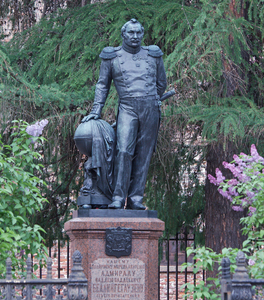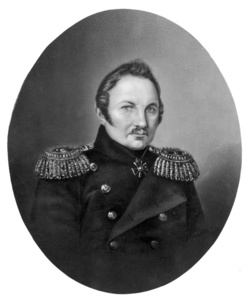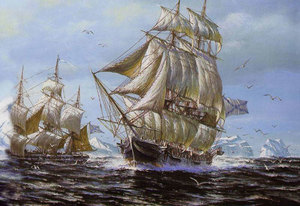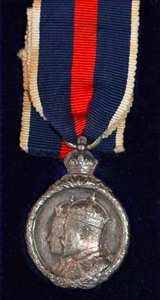BELLINGSHAUSEN, THADDEUS GOTTLIEB THADDEVICH von (also FABIAN GOTTLIEB BENJAMIN)
1779 - 1852 from Russian Empire (also Estonia)
Russian admiral and explorer. (His names have been variously rendered in German, Estonian and Russian; the second appears in his baptismal record.) He was born to a family of German Baltic aristocrats on the Estonian island of Oesel {Saaremaa} at the mouth of the Gulf of Riga. He entered the Imperial Russian navy at the age of ten and as a junior officer served under Adam von Krusenstern during the first Russian circumnavigation of 1802-1806, in the Nadezhda and Neva. These vessels sailed via Cape Horn into the Pacific Ocean to explore its northerly reaches, returning via the Cape of Good Hope to Kronstadt, the naval base at St Petersburg. Bellingshausen himself was recalled from duties in the Black Sea to lead a second circumnavigation thirteen years later, his second in command being Lieutenant Mikhail Lazarev, who had commanded the Suvorov during the round-the-world voyage of 1813-16 and who was appointed captain of the Mirnyy, under Bellingshausen in the Vostok. The expedition was sent by Tsar Alexander I to complement Captain James COOK's second great voyage in the Resolution of 1772-1775. Bellingshausen thus became the second circumnavigator of the Antarctic, following Cook and preceding BISCOE. The sloops Vostok and Mirnyy were unfortunately badly matched and Bellingshausen's journal often records the need to shorten sail in order for Mirnyy to catch up with her faster consort. Both vessels were copper sheathed, but the Mirnyy appears to have been better strengthened than the Vostok.
The ships departed from Kronstadt in July 1819 to sail easterward round the world and reached South Georgia at the end of the year, when they proceeded to complete Cook's charting by making a running survey of its inhospitable southern coast. Outlying Annenkov Island, made famous in the narratives of SHACKLETON's boat journey of 1916 in the James Caird, was thus discovered and named after one of the officers. Sailing southeast towards the South Sandwich Islands, Bellingshausen gave Russian names to the more northerly group of these not seen by his predecessor, which he called after the promoter of his voyage, the Marquis of Traversey, minister for naval affairs. Zavadovskiy Island, named after the able first lieutenant of the Vostok, was found to be an active volcano, depicted as such with the other islands by the expedition's artist Paul Mikhailov, in the Atlas of the voyage. By sailing east of the southern islands, Bellingshausen proved that the South Sandwich Islands could not form the tip of an Antarctic continent. It is worth noting that the Russian names of these early and unfrequented discoveries have largely survived. Although his ships must have approached very near to the ice-bound continental coast of what is now Dronning Maud Land, Antarctica, Bellingshausen made no claim to have discovered it, although he is generally recognised as having been the first to see it. Like Captain Cook, the Russian commander left the Southern Ocean at the end of the navigation season for the warm waters of the Pacific. There he refreshed his men and made further surveys among the islands, chiefly the Tuamotus, but spending time in Tahiti, where the expedition's astronomer Ivan Simonov corrected the chronometers at Cook's Point Venus. Bellingshausen devotes many pages to their stay on the island, where he breakfasted with King Pomare and was greatly helped by the missionary Henry Nott.
The Russians had made a remarkable voyage thus far. They had crossed the Antarctic Circle three times, for the third time in the same latitude and longitude as Captain Cook nearly fifty years earlier. 'Since leaving the South Sandwich Islands', wrote HR Mill, the historian of the Antarctic, 'the Russian ships had kept south of Cook's track and pushed the limits of human knowledge far to the southward of any previous explorer'. This was achieved despite storms, icy rigging, poor visibility and snow-encumbered decks, while navigating from time to time fog-bound, in danger of almost invisible drifting icebergs and heavy pack. Fortunately warm clothing and satisfactory food had been issued by the naval authorities. The crews too were picked men to whose welfare Bellingshausen paid great attention. After their first season in the ice, the expedition was made very welcome by Governor Macquarie in Sydney, where repairs were made to the ships. Bellingshausen wrote an interesting description of the infant colony of New South Wales and of the aboriginal inhabitants whom they met.
After being refitted in Sydney, the ships sailed south again on 31 October 1820 for Macquarie Island and the icy seas beyond, remaining south of latitude 60°S for just over two months, passing through no less than 145 degrees of longitude. On 24 December they crossed the Antarctic Circle for the fourth time in longitude 164°34'W in the midst of huge icebergs. Sadly most of the pet birds bought in the tropics died in the cold. Still skirting the pack ice, the Antarctic Circle was crossed for the fifth time in longitude 120°W. The expedition's furthest south, latitude 69°52'S, was reached on 1 January 1821, after crossing the Circle for the sixth time in longitude 103°W and avoiding numerous icebergs until stopped by a wall of ice. Following the edge of the pack and sailing eastwards, Peter I Island (Øy) was discovered - the first ever outpost of land found south of the Antarctic Circle, named after Tsar Peter the Great. On 28 January, land of larger extent was sighted in 73°10'W also south of the Circle, which was given the name of the reigning Tsar Alexander I, who had despatched the voyage. On 31 January, the ships crossed the Antarctic Circle northwards in longitude 76°W after sailing within it for two weeks for over 28 degrees of longitude, through the waters of what is now called the Bellingshausen Sea. On 4 February, the ships reached the South Shetlands, then recently discovered (as Bellingshausen had been informed in Sydney by William Smith) and charted by Edward Bransfield and later by James WEDDELL. Despite his careful survey of the chain of rugged snow-clad islands from south to north, which set a new standard for polar charts, and their depiction in his Atlas, the place-names bestowed by Bellingshausen did not survive. It was here that the well-known meeting between the Russian commander and the American sealer, Nathaniel Brown Palmer took place, about which Bellingshausen says very little in his book - mainly of Palmer describing the great numbers of fur seals killed (80,000) since the discovery of the islands. The Vostok and Mirnyy then sailed homeward after completing their circumnavigation off South Georgia, anchoring in Kronstadt on 24 July (old style*) 5 August (new style) 1821. Only three men had been lost during a perilous voyage of discovery of two years duration.
Bellingshausen's narrative, entitled in English translation, The twofold expedition in the Southern Ocean and the voyage round the world in 1819, 1820 and 1821 . . . and the fine atlas of charts and views were not published for another decade (St Petersburg, 1831). An abridged German translation of the narrative appeared in Leipzig (1902) and an excellent English one, edited by Professor Frank Debenham for the Hakluyt Society in 1945. The latter contains an introduction and numerous footnotes by the editor, a member of Captain Scott's last expedition, 1910-1913. Of particular relevance to the present work are the fine charts and views of the south-west coast of South Georgia and the South Sandwich Islands in the Russian Atlas. These and others interleave the English translation, much reduced, the placenames having been translated into English.
Bellingshausen greatly regretted the absence of naturalists on his voyage. Two Germans had been appointed to join at Copenhagen, but pleaded a lack of time to complete their preparations as an excuse to withdraw. 'Perhaps they were right' commented Bellingshausen 'but I, as a naval officer, cannot help thinking that all that a scientist need bring with him is his scientific knowledge'. He makes many remarks on the birds and other creatures in his narrative and the artist, Mikhailov, produced some very fine pictures of them (and of the scenery and the people) all to be found in the Atlas. The resumption of Russian activity in the Antarctic during the mid-twentieth century led to a renewed interest in Bellinghausen's voyage, including the publication of his charts in 1963 and of an abridgement of the twenty five notebooks kept by the astronomer, Ivan Simonov, in 1951.
After reading the English translation and studying the Russian Atlas, one feels tremendous admiration for Bellingshausen, his officers and men. They complemented Captain Cook's second great voyage in every respect, competing with it in none. While Bellingshausen may not be called the discoverer of the Antarctic continent, as maintained by certain Soviet historians, he was certainly the first to see it, although not recognising it as such. He became an admiral in 1831. His last appointment was as governor of the Russian naval base of Kronstadt, where he died in 1852.

Monument to Bellingshausen in ...
External links
References
Bellingshausen and the discovery of Antarctica - Polar Record; September 1971. See: Polar Record 1971
Fabien Gottlieb von Bellingshausen See: Antarctic Logistics
Comments
Revisions
June 2019 Illustration added
November 2019 Two additional photographs added; two external links added; two references added


